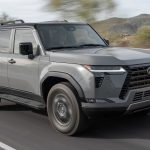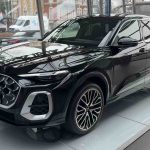Overview
The Ford Puma Gen-E represents Ford’s strategic entry into the competitive electric compact crossover segment for 2025. Building on the conventional Puma’s successful formula, the Gen-E version maintains the distinctive coupe-inspired silhouette while implementing comprehensive changes to accommodate its all-electric powertrain.
Visually, the Puma Gen-E differentiates itself with a closed-off front grille featuring an illuminated Ford badge, aerodynamically optimized wheels, and unique lighting signatures. The design successfully balances aerodynamic efficiency with the sporty character that has made the standard Puma popular among buyers seeking personality in the compact crossover segment.
The most significant development is underneath the familiar shape, where Ford has implemented its new dedicated electric platform. This architecture allows for a flat floor design, improved interior space, and optimal battery placement for enhanced weight distribution. Ford offers two battery capacity options: a standard 45 kWh pack targeting urban users and a larger 65 kWh option for those requiring extended range.
The Puma Gen-E is positioned as an accessible entry point into electric mobility while maintaining the engaging driving dynamics and practicality that defined its combustion-powered predecessor. By leveraging the established Puma nameplate and adding the “Gen-E” designation, Ford signals both continuity and the vehicle’s next-generation electric credentials.
Driving
The driving experience of the Ford Puma Gen-E delivers on the brand’s promise of making electric vehicles that maintain the engaging character Ford is known for. The base single-motor configuration produces 170 horsepower and 250 lb-ft of torque, delivering power to the front wheels. This setup provides spirited acceleration, with 0-60 mph times of approximately 7.3 seconds.
For those seeking enhanced performance, the dual-motor AWD variant (available only with the larger battery) increases output to 290 horsepower and 325 lb-ft of torque, reducing the 0-60 mph time to an impressive 5.8 seconds. The instantaneous torque delivery creates a responsive driving experience that feels more powerful than the numbers suggest, particularly in urban environments.
Ford has calibrated the regenerative braking system with three selectable levels, allowing for customization based on driver preference. The strongest setting enables effective one-pedal driving, while the lightest setting provides a more conventional feel that might appeal to EV newcomers. The blending between regenerative and friction braking is seamless, avoiding the inconsistent pedal feel that plagues some electric vehicles.
The Puma Gen-E’s handling characteristics benefit from the low center of gravity created by the underfloor battery placement. The suspension tuning—MacPherson struts up front and a multi-link rear setup—strikes an impressive balance between comfort and engagement. The ST-Line variant features a sport-tuned suspension with adaptive dampers that firm up noticeably in Sport mode without becoming harsh.
Steering feel is direct and appropriately weighted, with three selectable modes that alter assistance levels. While not offering the same feedback as the sportiest combustion Pumas, the precision and response remain satisfying. Road noise is well-managed thanks to additional sound insulation and acoustic glass, though tire noise becomes more noticeable without an engine to mask it, particularly with the optional 19-inch wheels.
The different drive modes (Eco, Comfort, Sport, and Individual) significantly alter the vehicle’s character by adjusting power delivery, steering weight, and in higher trims, the adaptive suspension firmness. The Puma Gen-E’s claimed range is 230 miles for the standard battery and up to a competitive 310 miles for the larger 65 kWh pack, though real-world testing suggests these figures are achievable only in favorable conditions.
Interior
The interior of the Puma Gen-E leverages the advantages of its dedicated electric platform to create a more spacious environment than the conventional Puma. The flat floor increases rear legroom and improves the feeling of spaciousness throughout the cabin. Ford has implemented a modern, minimalist design approach while maintaining adequate physical controls for primary functions.
The dashboard is dominated by a 13.2-inch touchscreen running Ford’s SYNC 4A system, which features EV-specific functions including charging station location, range estimation, and energy consumption monitoring. This is complemented by a 12.8-inch digital instrument cluster that offers multiple display configurations, including a minimalist mode that reduces potential distractions.
Material quality shows improvement over the standard Puma, with more soft-touch surfaces and recycled materials throughout the cabin. The ST-Line models feature distinctive red stitching, aluminum pedals, and sports seats with additional bolstering. The top-tier Titanium+ trim offers premium touches including a 10-speaker B&O sound system, ambient lighting with 64 color options, and ventilated front seats.
The Puma Gen-E retains one of the conventional model’s most praised features—the innovative “MegaBox” in the cargo area. This deep, waterproof storage compartment beneath the main cargo floor provides an additional 2.9 cubic feet of storage and can accommodate taller items in an upright position. Overall cargo capacity stands at 15.9 cubic feet with the rear seats in place, expanding to 45.6 cubic feet when folded—figures that remain competitive within the segment despite accommodating the electrical components.
Connectivity options are comprehensive, with wireless Apple CarPlay and Android Auto standard across the range. The FordPass Connect system allows remote monitoring and control of charging, climate preconditioning, and vehicle status via a smartphone app. Four USB-C ports (two front, two rear) and a wireless charging pad ensure all devices remain powered.
The overall interior environment successfully balances technology with usability, though some functions buried within the touchscreen would benefit from dedicated physical controls. The cabin provides a quiet, refined space that enhances the premium feel Ford aims to establish with this electric offering.
Buying
The Ford Puma Gen-E is positioned as a competitively priced entry in the electric compact crossover segment, with Ford leveraging production efficiencies from its existing Puma manufacturing to maintain reasonable price points despite the added cost of electrification.
The model range consists of four trim levels: Connect, Titanium, ST-Line, and the range-topping Titanium+. Each is available with either the standard 45 kWh battery or the extended-range 65 kWh option, though the dual-motor AWD configuration is limited to ST-Line and Titanium+ trims with the larger battery.
Ford’s warranty coverage for the Puma Gen-E includes an 8-year/100,000-mile guarantee on the battery (ensuring it maintains at least 70% of its original capacity) and a standard 3-year/36,000-mile bumper-to-bumper warranty. The vehicle qualifies for federal tax incentives of up to $7,500, along with various state and local incentives depending on the buyer’s location.
Charging capabilities include support for DC fast charging at up to 130 kW, allowing the larger battery to charge from 10-80% in approximately 32 minutes under optimal conditions. The standard 11 kW onboard charger can complete a full charge in about 6.5 hours on a Level 2 home charger for the larger battery variant.
Ford offers a complimentary Ford Connected Wallbox with professional installation for buyers who commit to a finance or lease agreement, adding value to the ownership proposition. The BlueOval Charge Network provides access to over 100,000 public charging stations with integrated payment through the FordPass app.
Maintenance costs should be significantly lower than combustion-powered alternatives, with scheduled service intervals of 20,000 miles focusing primarily on cabin air filters, brake fluid, and routine inspections. The regenerative braking system reduces wear on friction components, further lowering long-term ownership costs.
Predicted residual values appear strong based on the performance of other electric Ford models, though the rapidly evolving EV market makes long-term value forecasting challenging. The Puma Gen-E’s competitive range, practical design, and established nameplate should support stronger resale values compared to some less established electric alternatives.
Specs & Prices
Specifications:
- Powertrain Options:
- Single-motor FWD: 170 hp, 250 lb-ft torque
- Dual-motor AWD: 290 hp, 325 lb-ft torque (65 kWh battery only)
- Battery and Range:
- Standard Battery: 45 kWh usable capacity, 230 miles estimated range
- Extended Range Battery: 65 kWh usable capacity, 310 miles estimated range
- Charging:
- Maximum DC Fast Charging: 130 kW
- DC Fast Charge Time (10-80%): 28 minutes (45 kWh), 32 minutes (65 kWh)
- Onboard Charger: 11 kW
- Level 2 Charging Time (0-100%): 4.5 hours (45 kWh), 6.5 hours (65 kWh)
- Performance:
- 0-60 mph: 7.3 seconds (FWD), 5.8 seconds (AWD)
- Top Speed: 99 mph (limited)
- Dimensions:
- Length: 172.0 inches (4,370 mm)
- Width: 71.9 inches (1,825 mm) excluding mirrors
- Height: 62.8 inches (1,595 mm)
- Wheelbase: 104.3 inches (2,650 mm)
- Ground Clearance: 6.7 inches (170 mm)
- Curb Weight: 3,680-4,120 lbs (1,670-1,870 kg) depending on configuration
- Cargo Capacity:
- Rear Seats Up: 15.9 cubic feet (450 liters)
- Rear Seats Folded: 45.6 cubic feet (1,290 liters)
- MegaBox Capacity: 2.9 cubic feet (80 liters)
- Efficiency:
- Energy Consumption: 3.6 mi/kWh (FWD, 45 kWh), 3.4 mi/kWh (FWD, 65 kWh), 3.2 mi/kWh (AWD, 65 kWh)
Pricing (Reference prices for US market):
- Puma Gen-E Connect (45 kWh): $34,995
- Puma Gen-E Connect (65 kWh): $39,995
- Puma Gen-E Titanium (45 kWh): $37,495
- Puma Gen-E Titanium (65 kWh): $42,495
- Puma Gen-E ST-Line (45 kWh): $39,995
- Puma Gen-E ST-Line (65 kWh): $44,995
- Puma Gen-E ST-Line AWD (65 kWh): $47,995
- Puma Gen-E Titanium+ (45 kWh): $42,995
- Puma Gen-E Titanium+ (65 kWh): $47,995
- Puma Gen-E Titanium+ AWD (65 kWh): $50,995
Key optional packages:
- Technology Pack (advanced driver assistance features, 360° camera): $1,995
- Winter Pack (heated seats, heated steering wheel, heat pump): $1,295
- Panoramic Glass Roof: $995
- Premium Audio Package (B&O 10-speaker system): $795
- Towing Package (up to 2,200 lbs capacity): $695
Note: Prices may vary by region and dealer policies. Destination charge of $1,395 not included in listed prices. Federal tax credit of up to $7,500 may apply, along with state and local incentives depending on buyer’s location and circumstances.






















